You are going to have significant problems driving a low impedance speaker such as 8 ohms. To produce (say) 4 Vp-p across it requires that the peak current is 250 mA. This has to be delivered by the 2N2222 transistor on one half cycle of the waveform and by the 330R resistor (R5) on the other half cycle. Clearly, trying to take 250 mA through a 330R resistor needs a forcing voltage of at least 83 volts but you only have a 10 volt supply! So, my recommendation is to massively reduce R5 or preferably, use a push-pull output stage.
Given that the current gain of the output transistor might be 100, you will need to put at least 2.5 mA peak into the base but, taking 2.5 mA through R3 is not going to work because 8.25 volts will be dropped by it. This a similar story to that of R5 mentioned above.
Because of this you could set Q2 to have a much increased quiescent current of maybe 25 mA - this means reducing R4 considerably to something like 22 ohms AND reducing R3 to something like 220 ohms.
Now, when 2.5 mA is asked to be drawn through R3 it will drop about 0.55 volts and much more easily drive the final transistor Q1.
For the same reasons as above, you will need to reduce R1 and R2 because Q2 requires a quiescent current of 25 mA and, assuming it has a current gain of 100, its base will need 250 uA. The generally accepted rule here is that if the base needs "X" amount of current then the bias resistors ought to take 10 times this current. So choose R1 and R2 such that about 2.5 mA flows though them.
The other problem with distortion is C1 across emitter resistor R4 - it will make the output shape (if fed a sine wave) asymmetrical. This might catch you out later so please be aware of this.
I would also strongly urge you to use LTSpice (a free sim tool) to develop your ideas because its analysis of this simple problem will be more accurate than what I can do with pen and paper (no access to a sim today).
